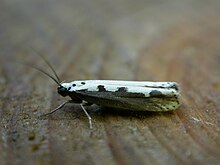→External links: clean up + cat using AWB |
Chris lepidoptera (talk | contribs) |
||
| Line 31: | Line 31: | ||
==External links== |
==External links== |
||
* [http://www.lepidoptera.eu/show.php?ID=1854 European Butterflies and Moths] |
|||
| ⚫ | |||
* [http://webh01.ua.ac.be/vve/Checklists/Lepidoptera/Ethmiidae/Ebipunctella.htm Lepidoptera of Belgium] |
* [http://webh01.ua.ac.be/vve/Checklists/Lepidoptera/Ethmiidae/Ebipunctella.htm Lepidoptera of Belgium] |
||
| ⚫ | |||
{{DEFAULTSORT:Ethmia Bipunctella}} |
{{DEFAULTSORT:Ethmia Bipunctella}} |
||
Revision as of 21:07, 28 January 2015
- The E. bipunctella invalidly described in 1936 by H. Rebel in L. Osthelder is actually E. distigmatella.
| Ethmia bipunctella | |
|---|---|

| |

| |
| Scientific classification | |
| Kingdom: | |
| Phylum: | |
| Class: | |
| Order: | |
| Family: | |
| Genus: | |
| Species: | E. bipunctella
|
| Binomial name | |
| Ethmia bipunctella (Fabricius, 1775)
| |
| Synonyms | |
|
Alucita bipunctella Fabricius, 1775 | |
Ethmia bipunctella is a diurnal moth from the family Ethmiidae. It can be found in Central and Southern Europe, North Africa, Asia and the northeastern part of North America. E. iranella was formerly included here as a subspecies.

The wingspan of the moth ranges from 19–28 millimetres (0.75–1.10 in). The flight time ranges from May to September. The moth is bivoltine, having two generations per year.
The most important host plant is the Viper's Bugloss, but also Anchusa officinalis and plants from the genus Symphytum. Pupae are attached to dead wood.
External links
- European Butterflies and Moths
- Lepidoptera of Belgium
- Recent sightings on waarneming.nl Template:Nl icon